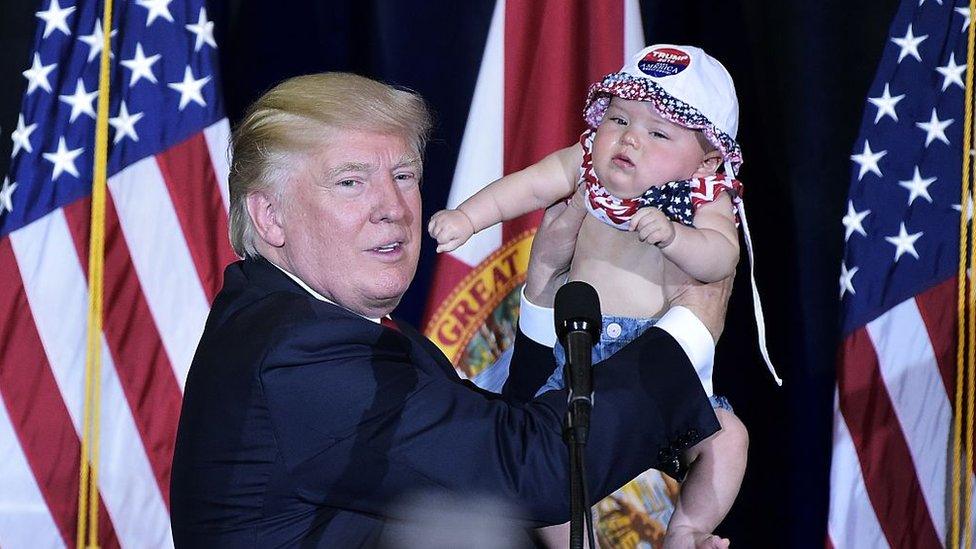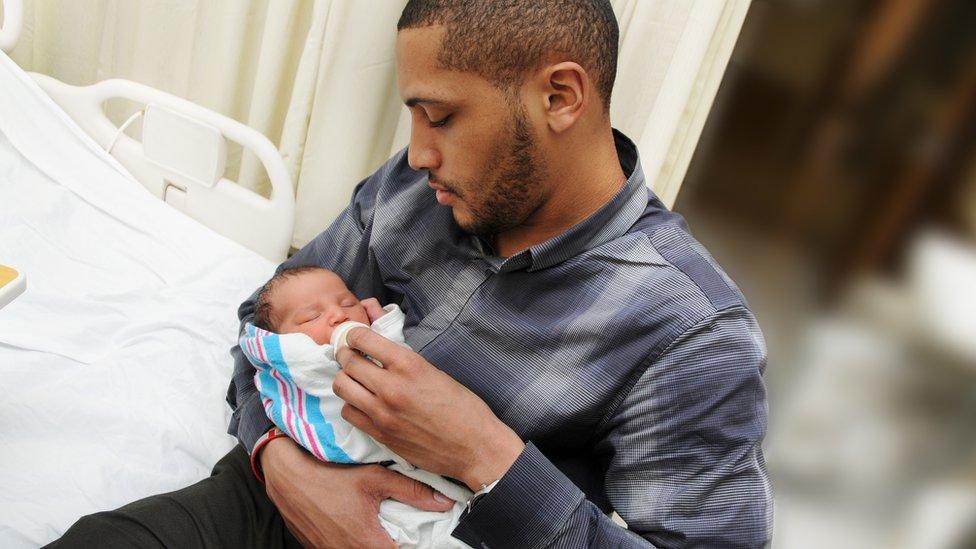Will Trump bring paid maternity leave to the US?
- Published

During the campaign, Donald Trump pledged to be the first Republican to propose paid family leave
Donald Trump's proposed 2018 budget would create the first federal plan for paid family leave in the US. How far does it go?
The US is the only developed nation in the world that does not provide some type of national paid family leave plan to new parents (only 8 other nations, external, including Papua New Guinea, Suriname and Tonga, do not provide paid leave).
California, New Jersey and Rhode Island have their own state-run paid family leave systems, and New York state and the District of Columbia have policies that haven't yet gone into effect, but that leaves the vast majority of the country uncovered.
In his proposed 2018 budget, Trump is bucking traditional party lines by proposing what would be the first federal family paid leave policy in US history. It has been widely reported that came at the insistence of his daughter, Ivanka, who has made "women who work" a central part of her newly forming political identity.

Ivanka Trump is said to have convinced her father to include paid family leave in his budget. How far does the proposal go?
"This is the first time a major Republican politician has recognized the importance of offering paid leave to new parents. That's a huge step," writes Christopher Ruhm, professor of public policy and economics at the University of Virginia, in an email to BBC News.
It is also one of the few added benefits in a budget that is filled with billions of dollars in cuts to social services and programmes.
"It kind of sticks out - it's almost the only domestic initiative in the entire budget," says Isabel Sawhill, senior fellow in economic studies at the Brookings Institution, and the former associate director of Office of Management and Budget for the Clinton administration. "Most of these social programmes are being slashed to the bone."
So, as a standout piece of policy that - in theory - could find favour with both Republicans and Democrats, what does Trump's plan do?
How would it work?
The plan would require that all new parents - including adoptive parents - receive six weeks of paid leave. While it will be a nationwide requirement, the benefits themselves would be administered by the states.
"The proposal will allow States to establish paid parental leave programs in a way that is most appropriate for their workforce and economy," the budget reads. "The proposal gives states broad latitude."
How long should mothers take off after they give birth?
This means the Trump budget is very light on specifics.
"You're seeing the skeleton, you're not seeing what's inside, how it will actually work," says Aparna Mathur, a resident scholar in economic policy studies at the American Enterprise Institute. "This is not much better than what they had on the campaign, and they've had months to think about this."
Payments to parents will come out of each state's Unemployment Insurance programme. Theoretically, a new parent would apply for the benefit the same way a newly laid-off worker would apply for benefits. The coffers of state Unemployment Insurance funds are filled by state and federal taxation on employers.
State control could also mean there would be significant variation in the exact amount of pay parents receive, who would be eligible, and how to apply - the current budget proposal does not address any of these specifics.
Mathur points out that in order to qualify for unemployment benefits in New York, a person must show she earned $1,900 in a calendar quarter. But in California, the minimum earnings amount to qualify for unemployment is $1,300. If those same kinds of standards are applied to paid leave eligibility, that would mean all new parents can apply but not all will be approved.
"This is not insuring uniform access to everybody across the US," says Mathur, while Ruhm notes that "Some states are well-equipped to do this but most are not."

How will it be funded?
The Trump budget says that the plan will cost $18.5bn over the course of 10 years, external.
The budget projects that $2.2bn would come from eliminating fraud in the system, while another $4bn would come from initiatives to get people off of unemployment benefits faster. Sawhill is sceptical of these figures.
"We've been trying to reduce improper payment for ever and ever. If it were easy, we would have done it by now," she says. "We're going to help people find jobs more quickly? Well, fine, but how?"
The rest of the money - about $13bn - would come from states raising their payroll taxes on employers.
"It's technically not the federal government raising taxes, maybe that's easier to swallow," says Marc Goldwein, senior vice president for the Committee for a Responsible Federal Budget.
But many state's unemployment trusts are already quite beleaguered. According to the US Department of Labor, external, only 21 states currently maintain the "minimal level of adequate solvency".
Anne-Marie Slaughter: A year's maternity is too long for mothers
How does it compare to other countries' plans?
Past congressional plans and the plan promoted from the Hillary Clinton campaign promised 12 weeks of paid leave, but even that pales in comparison to other nations.
The International Labor Organization recommends at least 14 weeks, external. India provides at least 26, Norway 44, while countries like Japan provide a full year of paid leave, though some experts like Sawhill say there's reason to believe that much leave can actually discourage women from re-entering the workforce.
Is this plan better than nothing?
"If states are able to implement some of this, it's definitely better than not having anything," says Mathur. "My worry is that states will view this as an unfunded mandate, and will not opt in at all - in which case no progress would have been made."
On the other hand, Betsey Stevenson, associate professor of public policy and economics at the University of Michigan, believes that the current proposal is too flawed to be seen as a good "first step".
"If we ended up settling there I think it would be a mistake, because it would be hard to get something new done once something has been implemented," she says.
The future of the proposal is anything but certain - it will have to find favour with Democrats who may wish to block any part of the Trump agenda, and with Republicans who have long lobbied against anything that might be seen as a new federal mandate.